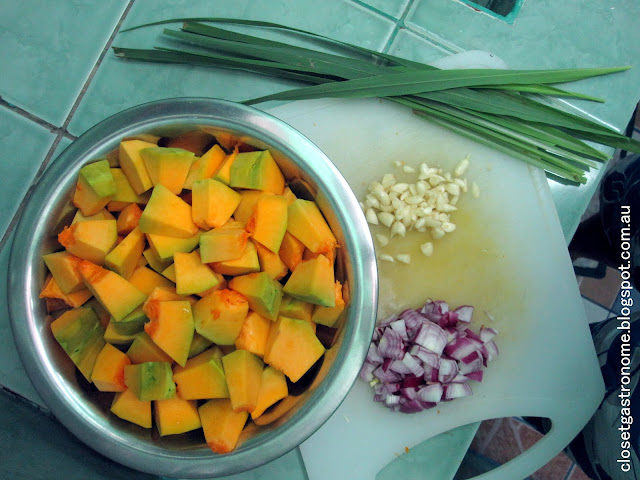⛄ ❄️ Winter—that time of the year when most of nature slumbers. In Australia, especially the area below the Tropic of Capricorn, we experience the depth of winter around July–August. 🌐 But for my dear friends in the upper latitudes of the Northern Hemisphere, it's already their winter around this period. One of my first winter experiences before was when I was still living somewhere in the left bank of the Garonne River several years back. The southwest of France has a maritime climate which gives the region mild winters and make snowfalls uncommon. Luckily, I got to experience a rare, short but sweet chute de neige during my stay there—even the bonhomme de neige ("snowman" ☃) we've made was literally short, haha... 😄
Il neige!
Why am I even talking about winter? Because I thought this soup I've cooked recently would be a good winter–warmer. 😋 🌞 Even then, winter or not, I believe that this soup is hearty enough to be served even in a tropical climate, where I am spending my Christmas holidays at the moment. 🎄 🌟
I have this leftover squash that I previously used for making squash and chickpea fritters and I thought I'd just turn it into a soup. I went online and scrambled for a recipe for a pumpkin or squash soup. However, for those recipes that I looked into, I don't have all the ingredients that they listed. 😕 There was also one recipe which calls for white wine, but I was too hesitant to open my 7–year old Vin de Pays Charentais – Sauvignon Blanc—better save this bottle for a special occasion, hehe... 🥂 So, I just cooked a creamy soup with what we have in our kitchen. It also helped that we have a lovely shrub of lemongrass growing in our outdoor planter box in front. 🌿 This aromatic herb gave a citrusy/lemony note which deliciously cuts through the unctuousness or creaminess of my potage. 🍋 According to Ben–Erik van Wyk's book (Culinary Herbs and Spices of the World – 2013), the subtle lemon flavour of lemongrass is mainly ascribed to the compounds called geranial and neral that this plant naturally contains. ⚗ 🤓
Structural formulae of the natural compounds responsible for lemongrass' lemony flavour
Anyway, enough of the chemistry and nerdiness and let's get into cooking! 😊 For the ingredients, I didn't exactly measure them and all were incorporated according to taste. Also, one important piece of equipment that we would need is an immersion or handheld blender. If you don't have one, a traditional blender would do, but just be careful when handling hot food!
🍲 Velouté de courge – Cream of Squash Soup 🥄
Ingredients:
vegetable oil ← I used canola
garlic ← I used 1 small head; peeled and crushed
onion ← I used 2 small heads; chopped
squash or pumpkin ← I had about 1 kg leftover from the fritters I've made; peeled and cut into chunks; some recipes suggest roasting the pumpkin/squash in the oven first, but I couldn't be bothered consuming additional heat energy 😑
chicken stock/broth ← I prepared about a liter; a commercially prepared stock or solid cube dissolved in boiling water would do; otherwise, we can also use natural chicken stock but we should prepare it beforehand
curry powder ← I think I used about 3 tbsp or more—I like it spicy 😋
cream ← I used all–purpose cream
lemongrass ← Be careful when cutting fresh stalks of grass from the main plant as the edges of the leaf blades can be very sharp! My knuckle actually got a small cut from doing so... *ouch* 😖
salt and pepper
Procedure:
– Sauté garlic first until light brown in colour then add the onions; Sauté the onions until translucent
– Add the squash chunks and cook a little bit
– Pour in the chicken stock (about 700 mL initially, when using ≈ 1 kg of squash), curry powder, and bring to the boil
– Process the squash chunks by using an immersion/handheld blender
– Add a little bit of cream; add more according to taste
– Adjust soup consistency with chicken stock as desired; If the stock you prepared is too salty, just use plain hot water instead, for adjusting the soup's texture
– Adjust seasonings (curry powder, salt, and pepper) as necessary
– Add the lemongrass blades before the end of cooking (i.e. let the herb infuse for ≈ 15 min or so before serving); As with many delicate herbs, this is to ensure that the volatile essential flavour molecules would stay longer than when added early on
– Serve hot in a soup bowl or mug with a dollop of cream (crème fraîche or Greek–style yoghurt would also do)—just make sure you don't include the lemongrass in your serving bowl/mug 😉; You may also top your soup with croûtons and other chopped herbs (e.g. chives, coriander, kutsay (garlic chives), marjoram, parsley, sage, scallions) according to your liking
🔪 Peeled and sliced squash
Some of the ingredients for my velouté de courge (clockwise starting from the left): squash, lemongrass, garlic, onion
My satisfying hot bowl of Cream of Squash Soup served with hot pan de sal—how's that for a winter–warmer or as a comfort food? 😋
Bon appétit! 😊 👌







































